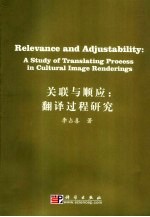
- 作 者:李占喜著
- 出 版 社:北京:科学出版社
- 出版年份:2007
- ISBN:7030182685
- 标注页数:196 页
- PDF页数:218 页
请阅读订购服务说明与试读!
订购服务说明
1、本站所有的书默认都是PDF格式,该格式图书只能阅读和打印,不能再次编辑。
2、除分上下册或者多册的情况下,一般PDF页数一定要大于标注页数才建议下单购买。【本资源218 ≥196页】
图书下载及付费说明
1、所有的电子图书为PDF格式,支持电脑、手机、平板等各类电子设备阅读;可以任意拷贝文件到不同的阅读设备里进行阅读。
2、电子图书在提交订单后一般半小时内处理完成,最晚48小时内处理完成。(非工作日购买会延迟)
3、所有的电子图书都是原书直接扫描方式制作而成。
Chapter One Introduction 1
1.1 Introduction 1
1.2 Translating Process:The Object of the Present Research 3
1.3 The Rationale of the Present Research 10
1.4 The Objectives of the Present Research 13
1.5 The Outline of the Present Study 16
Chapter Two A Review of the Relevant Literature 18
2.1 Introduction 18
2.2 The Related Translation Process Studies 19
2.2.1 The Psycholinguistic Approach 19
2.2.2 The Relevance-Theoretic Approach 22
2.3 Pragmatic Theories Related to the Present Study 25
2.3.1 Relevance Theory 25
2.3.2 Adaptation Theory 28
2.3.3 Translator as a Mediator 31
2.3.4 Pragmatic Equivalent Effect 32
2.4 Social Psychological Theories 34
2.5 Summary 36
Chapter Three Research Methodology and Data Collection 38
3.1 Introduction 38
3.2 Research Methodology 38
3.2.1 Theoretical Deduction 39
3.2.2 Example Analysis 41
3.3 Data Collection 41
3.3.1 Sources of Data 42
3.3.2 Data Analysis 44
3.4 Summary 46
Chapter Four The Relevance-Adjustability Theoretic Approach 47
4.1 Introduction 47
4.2 The Theoretical Basis of the Present Research 48
4.3 The Relevance-Adjustability Theoretic Approach 49
4.4 Variableness,Mediation and Adjustability:Possibilities for Translator's Choice-Making 53
4.4.1 Three Key Concepts and Their Interrelationships 54
4.4.2 Three Key Concepts and Translating Process 57
4.5 The Interplay of Translator's Subjectivity 58
4.5.1 Translator as Reader and Researcher 59
4.5.2 Translator as Substitute for Author,Recreator and Mediator 61
4.5.3 Translator's Other Subjectivity 63
4.6 A Tentative New Principle for Translator's Choice-Making 66
4.6.1 The Concept of Equivalence:A Critical Review 66
4.6.2 A Target Audience-Centered Principle of Cognitive Consonance 68
4.6.3 Implications of the New Principle 78
4.7 Summary 79
Chapter Five Discourse-Interpreting Communicative Process 80
5.1 Introduction 80
5.2 An Ostensive-Inferential Process 80
5.2.1 Author's Ostension and Translator's Cognition 82
5.2.2 Author's Strong and Weak Communication and Translator's Cognition 88
5.2.3 Author's Explicatures and Implicatures and Translator's Cognition 92
5.2.4 Author's Style and Translator's Cognition 97
5.2.5 Author's Procedural Meaning and Translator's Cognition 101
5.2.6 The Optimal Relevance:A Target for Translator's Cognition 104
5.3 Summary 107
Chapter Six Discourse-Producing Communicative Process 108
6.1 Introduction 108
6.2 A Dynamically-Adjusting Process 109
6.2.1 Contextual Correlates of Adjustability and Translator's Mental Workings 110
6.2.1.1 Translator's Adjustment Motivated by Social-Cultural Context 111
6.2.1.2 Translator's Adjustment Motivated by Linguistic Context 120
6.2.1.3 Translator's Adjustment Motivated by His Intentions 127
6.2.1.4 Translator's Adjustment Motivated by Target Audience's Aesthetic Expectations and Acceptability Level 130
6.2.2 Linguistic Correlates of Adjustability and Translator's Mental Workings 132
6.2.3 Dynamics of Adjustability in the Translating Process 141
6.2.3.1 Temporal Dimension and Dynamics of Adjustability 142
6.2.3.2 Translator's Social-Cultural Context and Dynamics of Adjustability 144
6.2.4 Pragmatic Awareness in the Adjustment Process 145
6.3 Summary 148
Chapter Seven Main Features of the Literary Translating Process 153
7.1 Introduction 153
7.2 Main Features of the Literary Translating Process 153
7.2.1 Relevancy 153
7.2.2 Indeterminateness 155
7.2.3 Variableness 156
7.2.4 Mediation 157
7.2.5 Adiustability 158
7.3 Interrelationship Between Main Features 159
7.4 Summary 167
Chapter Eight Concluding Remarks 168
8.1 Introduction 168
8.2 Summary of Major Findings 169
8.2.1 Major Findings on the Relevance-Adjustability Theoretic Approach 169
8.2.2 Major Findings on the Enrichment of the Existing Viewpoints 171
8.2.3 Major Findings on Main Features of the Literary Translating Process 174
8.3 Implications of the Present Research 175
8.4 Limitations of the Present Study 177
8.5 Suggestions for Future Research 178
Bibliography 179
Main Sources of Examples 195
